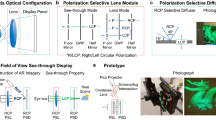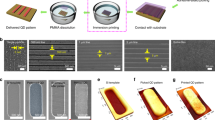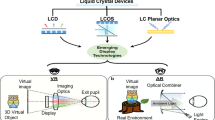Abstract
The human eye is a remarkable imaging device, with many attractive design features1,2. Prominent among these is a hemispherical detector geometry, similar to that found in many other biological systems, that enables a wide field of view and low aberrations with simple, few-component imaging optics3,4,5. This type of configuration is extremely difficult to achieve using established optoelectronics technologies, owing to the intrinsically planar nature of the patterning, deposition, etching, materials growth and doping methods that exist for fabricating such systems. Here we report strategies that avoid these limitations, and implement them to yield high-performance, hemispherical electronic eye cameras based on single-crystalline silicon. The approach uses wafer-scale optoelectronics formed in unusual, two-dimensionally compressible configurations and elastomeric transfer elements capable of transforming the planar layouts in which the systems are initially fabricated into hemispherical geometries for their final implementation. In a general sense, these methods, taken together with our theoretical analyses of their associated mechanics, provide practical routes for integrating well-developed planar device technologies onto the surfaces of complex curvilinear objects, suitable for diverse applications that cannot be addressed by conventional means.
This is a preview of subscription content, access via your institution
Access options
Subscribe to this journal
Receive 51 print issues and online access
$199.00 per year
only $3.90 per issue
Buy this article
- Purchase on SpringerLink
- Instant access to full article PDF
Prices may be subject to local taxes which are calculated during checkout




Similar content being viewed by others
References
Land, M. F. & Nilsson, D.-E. Animal Eyes (Oxford Univ. Press, New York, 2002)
Goldsmith, T. H. Optimization, constraint, and history in the evolution of eyes. Q. Rev. Biol. 65, 281–322 (1990)
Walther, A. The Ray and Wave Theory of Lenses (Cambridge Univ. Press, Cambridge, UK, 1995)
Swain, P. & Mark, D. Curved CCD detector devices and arrays for multi-spectral astrophysical applications and terrestrial stereo panoramic cameras. Proc. SPIE 5499, 281–301 (2004)
Grayson, T. Curved focal plane wide field of view telescope design. Proc. SPIE 4849, 269–274 (2002)
Khang, D. Y., Jiang, H., Huang, Y. & Rogers, J. A. A stretchable form of single crystal silicon for high performance electronics on rubber substrates. Science 311, 208–212 (2006)
Jackman, R. J., Wilbur, J. L. & Whitesides, G. M. Fabrication of submicrometer features on curved substrates by microcontact printing. Science 269, 664–666 (1995)
Paul, K. E., Prentiss, M. & Whitesides, G. M. Patterning spherical surfaces at the two-hundred nanometer scale using soft lithography. Adv. Funct. Mater. 13, 259–263 (2003)
Miller, S. M., Troian, S. M. & Wagner, S. Direct printing of polymer microstructures on flat and spherical surfaces using a letterpress technique. J. Vac. Sci. Technol. B 20, 2320–2327 (2002)
Childs, W. R. & Nuzzo, R. G. Patterning of thin-film microstructures on non-planar substrate surfaces using decal transfer lithography. Adv. Mater. 16, 1323–1327 (2004)
Lee, K. J., Fosser, K. A. & Nuzzo, R. G. Fabrication of stable metallic patterns embedded in poly(dimethylsiloxane) and model applications in non-planar electronic and lab-on-a-chip device patterning. Adv. Funct. Mater. 15, 557–566 (2005)
Lima, O., Tan, L., Goel, A. & Negahban, M. Creating micro- and nanostructures on tubular and spherical surfaces. J. Vac. Sci. Technol. B 25, 2412–2418 (2007)
Radtke, D. & Zeitner, U. D. Laser-lithography on non-planar surfaces. Opt. Express 15, 1167–1174 (2007)
Ruchehoeft, P. & Wolfe, J. C. Optimal strategy for controlling linewidth on spherical focal surface arrays. J. Vac. Sci. Technol. B 18, 3185–3189 (2000)
Xia, Y. et al. Complex optical surfaces formed by replica molding against elastomeric masters. Science 273, 347–349 (1996)
Hsu, P. I. et al. Spherical deformation of compliant substrates with semiconductor device islands. J. Appl. Phys. 95, 705–712 (2004)
Hsu, P. I. et al. Effects of mechanical strain on TFTs on spherical domes. IEEE Trans. Electron. Dev. 51, 371–377 (2004)
Jacobs, H. O., Tao, A. R., Schwartz, A., Gracias, D. H. & Whitesides, G. M. Fabrication of a cylindrical display by patterned assembly. Science 296, 323–325 (2002)
Zheng, W., Buhlmann, P. & Jacobs, H. O. Sequential shape-and-solder-directed self-assembly of functional microsystems. Proc. Natl Acad. Sci. USA 101, 12814–12817 (2004)
Boncheva, M. et al. Magnetic self-assembly of three-dimensional surfaces from planar sheets. Proc. Natl Acad. Sci. USA 102, 3924–3929 (2005)
Boncheva, M. & Whitesides, G. M. Templated self-assembly: Formation of folded structures by relaxation of pre-stressed, planar tapes. The path to ubiquitous and low-cost organic electronic appliances on plastic. Adv. Mater. 17, 553–557 (2005)
Huang, Y. Y. et al. Stamp collapse in soft lithography. Langmuir 21, 8058–8068 (2005)
Zhou, W. et al. Mechanism for stamp collapse in soft lithography. Appl. Phys. Lett. 87, 251925 (2005)
Sun, Y. et al. Controlled buckling of semiconductor nanoribbons for stretchable electronics. Nature Nanotechnol. 1, 201–207 (2006)
Begbie, G. H. Seeing and the Eye 92–93 (Natural History Press, Garden City, New York, 1969)
Born, M. & Wolf, E. Principles of Optics 7th edn (Cambridge Univ. Press, New York, 1999)
Acknowledgements
We thank T. Banks, K. Colravy, and J. A. N. T. Soares for help using facilities at the Frederick Seitz Materials Research Laboratory. The materials and optics aspects were developed in work supported by the US Department of Energy, Division of Materials Sciences under Award No. DE-FG02-07ER46471, through the Materials Research Laboratory and Center for Microanalysis of Materials (DE-FG02-07ER46453) at the University of Illinois at Urbana-Champaign. The processing approaches and the mechanics were developed in work supported by the National Science Foundation under grant DMI-0328162. C.-J.Y. acknowledges financial support from the Korea Research Foundation (grant KRF-2005-214-D00329) funded by the Korean Government (MOEHRD). J.B.G. acknowledges support from a Beckman postdoctoral fellowship.
Author Contributions H.C.K., M.P.S., V.M. and J.A.R. designed the experiments. H.C.K., M.P.S., J.S., V.M., W.M.C, C.-J.Y., J.B.G., J.X., S.W., Y.H. and J.A.R. performed the experiments and analysis. H.C.K., M.P.S., J.S., Y.H. and J.A.R. wrote the paper.
Author information
Authors and Affiliations
Corresponding authors
Supplementary information
The file contains Supplementary Methods and Discussion; Supplementary Figures S1-S29 and Legends
The text and Supplementary Figures S1-S29 provide detailed fabrication methods, a electrical response characterization of the hemispherical cameras, and a discussion of the optical testing procedures. Mechanics models to describe the planar to hemispherical transformation process and the strains in the hemispherical focal plane arrays are presented. (PDF 5886 kb)
The file contains Supplementary Movie 1
This movie shows the data acquisition process using a hemispherical camera. A series of photographs or movie is captured, using the computer interface shown on the left, as the image text "E-EYE" is slowly translated across the objective. The movie is shown in real time. (QT 7188 kb)
The file contains Supplementary Movie 1
This movie shows a hemispherical camera being used to collect a high resolution image. The camera scans over the entire "E" image using a series of small eucentric rotations, in this case scanning from -20 to 20° in both the θ and ϕ directions in 5° increments. (QT 5569 kb)
Rights and permissions
About this article
Cite this article
Ko, H., Stoykovich, M., Song, J. et al. A hemispherical electronic eye camera based on compressible silicon optoelectronics. Nature 454, 748–753 (2008). https://doi.org/10.1038/nature07113
Received:
Accepted:
Issue Date:
DOI: https://doi.org/10.1038/nature07113



